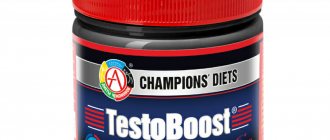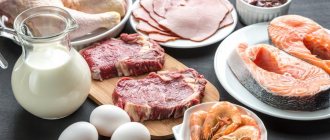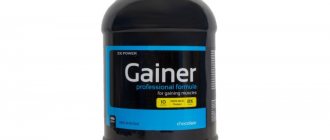Lack of control over the amount of energy consumed in the diet to gain muscle mass
Many people believe that during the period of gaining muscle mass, it is enough to eat as much as possible, literally consuming everything that is “not nailed down.” However, the concept of “a lot,” when determined by eye, characterizes the quantity very subjectively. Appetite and the degree of satiety after consuming certain foods can be very individual, and what for one is “to the point of satiety”, for another it is just “to kill a worm.” In practice, it most often happens that people who claim to eat a lot, but do not count the amount of proteins, fats and carbohydrates they eat, actually do not reach the required calorie content due to low appetite and rapid satiety from eating food. That is, they eat up even before the body receives the required amount of macronutrients. And constant satiety serves for them as the only criterion for the completeness of the diet for weight gain. If you don't feel like eating, then everything is fine. Somewhat less common are those who overeat when eating uncontrolled. These people have a good appetite and do not have difficulty gaining weight. Moreover, a constant increase in body weight is often a guideline for them that they are doing everything right. If your weight increases, your muscle mass also increases. This is partly true, but it is possible that most of the increase in body weight is due to an increase in the amount of fat in the body and fluid retention. I agree that excess fat can then be “dried off” with a diet, but only at this stage many people get burned. Not everyone has the willpower to fully dry, and it is especially difficult for those who have a good appetite.
If an athlete is interested in gaining muscle mass and gaining it at an adequate pace, but the current situation does not suit him, then something needs to be changed in the diet. However, how can you make dietary changes to gain muscle mass that is virtually uncontrolled?
If your diet lacks 500 calories for successful muscle growth, then you need to add 500 calories, and not just increase the portion size. Of course, the latter is better than nothing, but taking into account the fact that the foods included in the diet change all the time, the method of preparing them changes, their combinations with each other change (which is also determined by appetite), there is no guarantee that the calorie content will increase to the required level . Exactly the same with a clear overkill of calories. If a dominant increase in fat is obvious and there is a desire to prevent this, then how to reduce the amount of incoming energy to the optimal level without knowing the numbers. By eye you can end up in a deficit. Although you can always meet lucky ones for whom everything works out successfully even without exact calculations. Professional instinct, nothing less. But are there many of them?
Macroperiodization and microperiodization
It all depends on the construction of nutritional and training complexes. The usual cycle includes macroperiodization. What is its essence? It's quite simple - one step forward, one step back. Then two steps forward and one step back. First, we all gain muscle mass, and at the same time we gain glycogen reserves and, alas, body fat.
With proper training and nutrition planning, the set goes as follows:
- 200-300 g of muscle mass. The set depends on the level of metabolism and the level of the hormone testosterone - a direct stimulator of muscle protein synthesis.
- 500-1000 g of glycogen. Here everything is limited by the size of the glycogen depot. Thus, experienced athletes can gain up to 3 kg of glycogen per cycle.
- 1-3 liters of water. Since water is the main transport for all types of substances in our body, 3 liters of water per cycle is a systematic norm.
- 1-2 kg of adipose tissue.
Pure muscle mass accounts for about 10% of the total gain, or even less. Next, after several strength and mass-gaining cycles, athletes begin a drying period.
During the drying process (especially intensive), the following consumption occurs:
- 50-70 g muscle mass.
- 100-300 g of glycogen.
- 2-4 liters of water.
- 2-5 kg of adipose tissue.
Note: the so-called vacuum situations are considered above - i.e. with ideal adherence to the daily regimen, proper nutrition and training aimed at targeted fat burning.
After taking a few steps forward, the athlete takes a step back. In classic bodybuilding, periodization allows you to maintain the maximum amount of muscle mass, while losing as much body fat as possible. On average, using the classic system - 9 months of mass gain versus 3 months of cutting - the athlete receives a cumulative increase of up to 3 kg of pure muscle mass, and up to 20 kg of glycogen (it all depends solely on the characteristics of the body and the period).
Often the body fat becomes smaller than before the start of intense exercise.
With such periodization, simultaneous gain of muscle mass and drying is possible only during training, when the body intensively loses excess fluid, and super-recovery processes continue to stimulate the growth of protein tissue. However, the overall increase will be insignificant even when scaling this process for 1 month.
Conclusion: any classic athlete who does not use anabolic steroids will say that you cannot cut and gain muscle mass at the same time.
Now let's move on to microperiodization. This approach is used by athletes who engage in martial arts. After all, they need to constantly increase their speed and strength indicators, but at the same time maintain the same mass throughout the year.
The principles of microperiodization are almost identical to macroperiodization - only the period changes:
- Over the course of 3 weeks, you intensively gain muscle mass and glycogen reserves, trying to build metabolic processes in such a way that the overall increase in body fat is minimal.
- Then, in the 4th week, you begin a sharp transition to carbohydrate alternation or any other periodization diet. Being in its limit, you waste a huge amount of body fat.
- At the end of the month, you get the preservation of fat mass at the same level (a small gain or loss will be a statistical error), which is compensated by a gain of pure muscle mass.
Will such a result be noticeable in the short term? No! Will it be noticeable in the long term? Yes!
Whether this is considered simultaneous cutting and gaining muscle mass is another question. If we consider each period separately, then we cannot talk about simultaneous processes. But if we look at it in terms of macroperiodization, the answer is obvious... You have lost body fat and gained muscle mass.
Focus on the little things: how much protein do you need to gain muscle mass?
In organizing the nutrition process aimed at gaining muscle mass, there are certain nuances that promise additional benefits. However, often these nuances are given paramount importance to the detriment of the basics.
What comes first? Quantity, namely an adequate amount of protein for gaining muscle mass, as well as fat and carbohydrates, providing the body with the necessary plastic material and energy.
What's secondary? Meal frequency. Just because you eat 3 or 5 times, muscle growth will not change significantly. You can consume protein 3 times for 50 grams, or 5 times for 30 grams. Within a reasonable frequency of nutrition, these 150 grams of protein will provide the same benefit. Since “on the mass” you have to eat a lot, the number of meals will be limited by the capabilities of the digestive system. It is unlikely that she will cope with the daily calorie intake of 3000-4000 accepted at one time. This is not reasonable. And, if 150 grams of protein at one time is not so much for our gastrointestinal tract, then when you add 80 grams of fat and 400 carbohydrates to this amount, then there will be a war in the stomach.
- Type of protein. We have been taught that in the morning and after training we need fast proteins, and slow ones at night and during the day. Whey in the morning, casein before bed. Is there any logic to this? Undoubtedly. What would actually happen if whey and casein were swapped? Nothing will change, or rather muscle growth will not change. What if you eat meat instead of whey protein after a workout? Will muscles stop growing? No. No study has shown that manipulating the time travel of a particular type of protein provides a significant benefit. Although temporary changes are always recorded. For example, whey protein produces a greater increase in muscle protein synthesis, while casein has a greater inhibition of proteolysis (muscle breakdown). Both are important for hypertrophy. It is possible that under IDEAL conditions some scheme that distributes fast and slow proteins throughout the day will bring 10% more muscle mass in a month, but creating IDEAL conditions is not realistic. Nutrition in general, sleep, life stresses, the training process - all this also affects growth and all this can vary over the course of a month, sometimes not for the better. Therefore, no one has yet identified the best scheme, but it is certain that a chronic lack of protein (or energy) will lead to less results than is possible, even under ideal conditions.
PS But someone seriously believes that his muscles are not growing properly, because after training he drinks whey concentrate instead of a faster, but more expensive hydrolyzate.
— Timing your protein intake around your workout. The anabolic effect of protein foods lasts ~ 6 hours and scientific recommendations (for example, coming from ISSN), based on this circumstance, state that training should fall within this time interval. Then the increased protein synthesis in the muscles, induced by the load, will increase due to the synergistic effect of amino acids entering the cells. If the workout ends 6 hours after the previous meal, then in this case it will be useful not to put off post-workout protein intake. Under other circumstances, there is no urgent need to eat right in the gym locker room, although this is not prohibited, especially if it will help you gain your daily requirement.
In general, it is not a mistake to pay great attention to the little things, there is nothing wrong with choosing one or another type of protein for yourself, consuming it at one time or another, using any supplements. But when all this is the only thing that is controlled and taken into account in the diet, then this is not entirely correct. What good is it when you consume your protein if when you gain muscle mass you do not gain even a minimal energy surplus (point 1 again)?
Lack of control over the quality of fat consumed
Fat is an essential macronutrient that provides energy, including energy for muscle growth, and is an integral part of a proper diet for muscle gain. However, it doesn’t matter what kind of fats we gain this energy from. To put it as simply as possible, the fat that we eat, as well as the fat stored in our body, consists of two types of fatty acids, saturated and unsaturated. When gaining muscle mass, our diet must provide a surplus of energy, which is also characterized by some accumulation of fat mass. Depending on what type of fatty acids predominates in food, this type of fatty acids will be predominantly stored in our fat depots. This happens not only in humans, but also in animals. For example, in poultry farming it is practiced to feed chickens with vegetable oils, which changes the amount and ratio of fatty acids contained in the egg yolk (flaxseed oil in the chicken diet increases the amount of alpha-linoleic acid several times) Why is this important to know?
Yes, because unsaturated fats are more easily mobilized from fat depots and used more quickly as an energy source than saturated fats. For this reason, saturated fat accumulates to a greater extent and is more difficult to leave its storage places, both during the day (for example, at night) and when switching to drying. Research shows that creating a surplus from saturated or unsaturated fats leads to slightly different consequences for body composition. The total weight in both cases changes the same, but the qualitative component of this weight is different. When creating a surplus of saturated fats, the amount of accumulated fat is greater and its localization in the visceral area is more pronounced (and this is associated with the development of insulin resistance and lipid profile disorders). A surplus due to unsaturated fats leads to slightly less fat accumulation and (attention!) contributes to an increase in muscle mass. That is, part of the excess fat energy from saturated fatty acids is used by muscles for growth. In places where fat accumulates, which are “problematic” for us, in the sense that fat is the last to leave, a predominant accumulation of saturated fats is recorded. By modeling the composition of our fat “basket,” we also change the composition of adipose tissue—the set of fatty acids it contains. The predominance of unsaturated ones will provide us with further successful work on the quality of muscles built during the period of mass gain. (More on this in a separate article)
Training planning
After drawing up a diet, proceed to microperiodization of training complexes. Here everything is somewhat more complicated: although training is less important than diet, without it mass gain, a determining factor in the process of microperiodization, is impossible.
| Phase | Phase time | Workout |
| Mass recruitment | 3 weeks | Heavy circuit training - working the entire body at least once a week. The remaining workouts should be a systematic split, loading the largest muscle groups. It is important to maintain high intensity with an overall short training complex. |
| Maintenance | 1 Week | Mostly split. To slow down metabolism as much as possible, it is recommended to temporarily abandon basic complexes. We work small muscle groups. We completely refuse cardio exercises, including warm-up ones. For warming up, it is better to use stretching complexes. This is the perfect time to work on your abs. |
| Drying | 5-7 days | Exclusively cardio exercise. The training cycle should be a two-day split, working half the body per workout with basic exercises in pumping mode for blood signature and glycogen reduction. Avoid any heavy exercise. After each basic exercise, perform 2-3 isolating exercises. The total training time, including cardio, should be about 120-150 minutes. It is recommended to use 4-6 workouts per week to achieve optimal levels of fat loss. |
| Mass recruitment | 3 weeks | Heavy circuit training - working the entire body at least once a week. The remaining workouts should be a systematic split, loading the largest muscle groups. It is important to maintain high intensity with an overall short training complex. |
| Maintenance | 1 Week | Mostly split. To slow down metabolism as much as possible, it is recommended to temporarily abandon basic complexes. We work small muscle groups. We completely refuse cardio exercises, including warm-up ones. For warming up, it is better to use stretching complexes. This is the perfect time to work on your abs. |
| Drying | 5-7 days | Exclusively cardio exercise. The training cycle should be a two-day split, working half the body per workout with basic exercises in pumping mode for blood signature and glycogen reduction. Avoid any heavy exercise. After each basic exercise, perform 2-3 isolating exercises. The total training time, including cardio, should be about 120-150 minutes. It is recommended to use 4-6 workouts per week to achieve optimal levels of fat loss. |
| Mass recruitment | 2 weeks | Heavy circuit training - working the entire body at least once a week. The remaining workouts should be a systematic split, loading the largest muscle groups. It is important to maintain high intensity with an overall short training complex. |
| Maintenance | 2 week | Mostly split. To slow down metabolism as much as possible, it is recommended to temporarily abandon basic complexes. We work small muscle groups. We completely refuse cardio exercises, including warm-up ones. For warming up, it is better to use stretching complexes. This is the perfect time to work on your abs. |
| Drying | 7-10 days | Exclusively cardio exercise. The training cycle should be a two-day split, working half the body per workout with basic exercises in pumping mode for blood signature and glycogen reduction. Avoid any heavy exercise. After each basic exercise, perform 2-3 isolating exercises. The total training time, including cardio, should be about 120-150 minutes. It is recommended to use 4-6 workouts per week to achieve optimal levels of fat loss. |
| Mass recruitment | 3 weeks | Heavy circuit training - working the entire body at least once a week. The remaining workouts should be a systematic split, loading the largest muscle groups. It is important to maintain high intensity with an overall short training complex. |
Working out during this period is characterized by the same serious changes in periodization as during nutrition.
We must not forget about such important aspects as:
- Constant shock to the muscles. Do not use the same training exercises when changing complexes. Example: if in the first cycle of mass gain you used deadlifts and squats with a barbell behind your back, then in the second cycle of mass gain use the Romanian deadlift with a trap bar, supplementing it with a squat with a barbell on the front.
- Do not use more than 50% of a single approach during drying periods.
- Don't do interval cardio - it can burn a lot of muscle if you can't keep track of your heart rate zone.
- During the support period, you can completely abandon basic exercises. Do not train more than 3 times a week; training time should be about 30 minutes.








